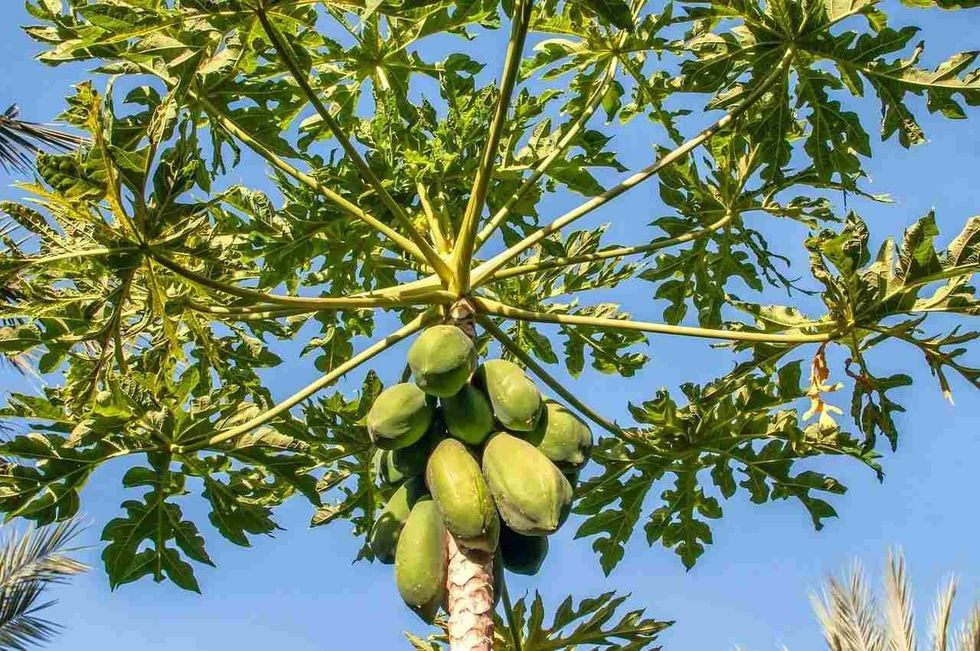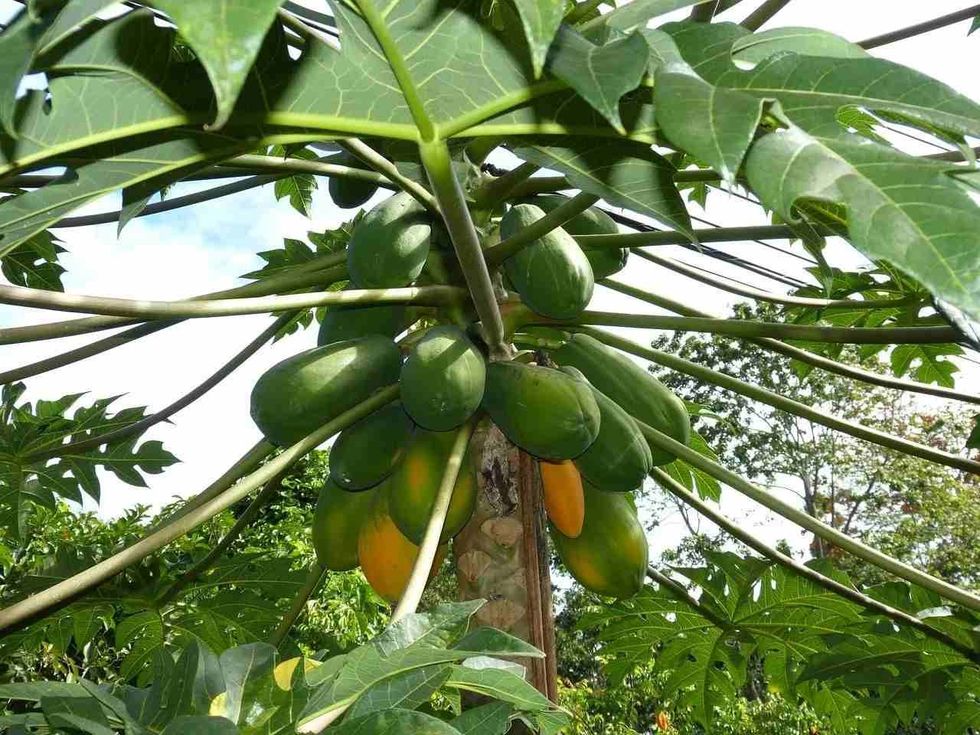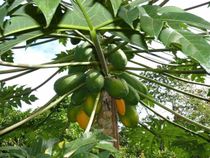Papaya Tree: Learn All About Growing And Caring For The Popular Plant

The papaya tree is a plant commonly known as papaya, papaw, and pawpaw.
Its scientific name is the Carica papaya tree and it belongs to the family Caricaceae. This plant is among the 22 species that are accepted in the genus Carica.
Talking about its origin, we find this plant in America’s Tropical Regions, especially in Central America and Mexico. This is a native plant of South America and is also found throughout Hawaii, Florida, Texas, the Caribbean Islands, California, and tropical areas all around the world.
Rich in vitamin C and carbohydrates, the papaya tree plant contains as much as 88% water, 11% carbohydrates, and 1% fat and proteins. Other than that, the net content of nutrients in the fruits of this plant is relatively low.
Papaya trees also have some traditional medicinal use, with the leaves being used to help treat malaria, and even occasionally being used to help relieve asthma.
Every plant is unique in nature and requires different nutrients and nurturing techniques. While some are better suited to summers, some simply need watering weekly. It's important to keep these different specifications in mind while looking for and keeping a plant.
From sowing seeds to the day the plant bears fruits, there is a lot to be done by the gardener. The Green mountain papaya plant, a popular fruit-bearing plant from Mexico, is not only famous but has some interesting facts and cultivation techniques associated with it.
Not only does this plant provide some delicious fruits, but it also serves some Ayurvedic medicinal purposes, which is a type of traditional medicine using a range of treatments.
How to grow papaya trees?
Knowing the right way to sow a plant is really crucial in growing a plant. Growing healthy green papaya is not at all as easy as most fruiting plants are. The reason is the care and patience it needs to be given before you can finally harvest its fruits.
Though one can easily buy papaya from the local grocery store, the taste of the home harvested fruits is much richer and sweeter, so let's understand how to grow papaya.
Before you actually sow the seed, some prior preparation is required. This includes the right sort of soil mix, the right choice of the seed, and the place in which the seed will be first sown.
For example, you can start by sowing the seed in a pot or a bag. Papaya plants grow to a decent height, so you'll either need a big pot or a grow bag.
After this, it's important that you mix the right amount of nutrients with the soil.
The soil should remain friable and light, with a proper drainage system for the extra water. In terms of the seeds, the papaya seeds will settle down in a water tumbler and will nurture in a healthy plant.
After understanding the necessities of the papaya plant, let us look at how to grow papaya so you end up with your very own papaya trees.
The first step will involve sowing the papaya seed. Set the seeds at a suitable distance from each other in either a seedling tray or a small container.
Within 10 days of planting the seeds to grow papaya, you'll be able to observe small saplings coming out of the soil.
After you observe approximately four to five leaves, it's time to transfer the young plants to a pot. It's important not to plant more than one sapling in a pot.
Once you've planted your sapling, it's important to remember you should water the plant every day. Though don't worry if you forget, you can skip a day once in a while and it won't hurt the papaya plants.
Sprinkle some natural pesticides, if you want to keep away the insects from your growing plant.
Make sure that you keep adding manure and fertilizer every once in a while, especially before fruiting time.
While these steps will help you to be able to grow papaya, it's important that you have plenty of patience and dedicate time to properly look after the plant. These steps will help you to gain ripe fruit during fruiting time.
Growing Papaya In Cooler Climates
It's not only the atmospheric temperature but also the soil temperature that determines how healthy the papaya trees will grow and what type of papaya fruit they will bear.
Freezing temperatures might make these bisexual plants lose their flower or very hot weather might provide rotten fruits or misshapen fruits that aren't fit to eat. Sometimes the conditions mean that the seeds for a papaya plant aren't worth growing. But what if cold weather hits when otherwise the soil is a good condition for papaya trees?
A slight freezing temperature of 32 F (0 C) can be enough to cause severe damage to your papaya plant. Even just one overnight freeze can be enough to kill the entire plant.
To prevent this, you can reduce watering during cold temperatures, as the soil is already wet and cold. You can also provide warmth to the papaya tree through some festival lights or even by building a shade of a blanket. The shade tree will be worth the effort you take to build it.
The same goes with hot weather, thus there are again some steps that can be taken to ensure the healthy growth of the papaya tree. Though papaya plants love full sun, temperature reaching over 90 F (32.2 C) can make the flowers, both male flowers, and female flowers fall.
Once the flowers fall, they will not bear any fruits. So, to ensure that the papaya fruits will be sweet and healthy, one should ensure proper watering during this tough, warm weather.
Water the plant daily, or even twice a day with proper water that seeps deep inside. While Carica papaya enjoys warm weather and full sun, exceedingly hot temperatures might cause misshapen fruits.
Some Common Problems When Growing Papayas
Growing papayas in your home can be a great and organic way to get healthy food in your home. We all have heard about the significant health benefits that papaya gives by eating it on a daily basis.
It's believed that eating papayas regularly can help reduce the risk of heart diseases, cancer, and diabetes. Papaya can help with digestion and improve blood glucose control in people who are ill with diabetes, helping to lower their blood pressure and improving their health.
Papaya is rich in vitamins A, B, C, and K. The fruit helps in building our immunity to fight back various diseases that we encounter in our bodies.
We also know the plant as pawpaw, which is believed to be from Central America’s Caribbean region. Normally eaten as raw and ripe papaya, people sometimes use papaya for cooking food, to make medicines, and for the flavors and essence too.
This all-rounder fruit sometimes doesn't agree with everyone. It's advised that pregnant women should not eat raw papaya.
When unripe, the fruit has a high latex content and could stimulate contractions. Also, raw papaya juices can induce early periods in women as well.
In its raw stage, the fruit is filled with fiber. And that property could help some people get all the toxins out of their bodies. Grated raw papaya is said to be a great at-home remedy to help your digestive tract and colon for proper digestion.
Even acne, pigmentation, and blemishes are known to be cured using this home remedy of raw papaya juices. So you can see there are both positive and negative health benefits to eating papaya depending on your circumstances.
Growing this rich fruit can be much harder than you might imagine. Your papaya seedlings may fail, they may damp off. Many other native soil and root and fungi problems may cause issues with your papaya tree. Some of the major problems that you may face while growing papayas are:
Damping-off papaya seeds: this fungal disease can affect the seeds of this fruit-bearing tree.
A large number of fungi are known to cause this disease in papaya seeds and plants, among them phytophthora parasitica, ultimum and pythium aphanidermatum. The young seeds of the papaya tree might become affected by these fungi.
Even so, with proper care papaya trees are known to grow old and develop resistance overtime against fungi, to aid in their development and increase their chances of survival, meaning you'll be able to enjoy the fruit from your tree.
Stem rot or foot rot (root rot) of papaya plant: the region of rotted stem or foot turns a dark black or brown in color while rotting. The extra water which has been soaked in these regions makes it enlarge and grindles the affected part of the plant.
The whole plant falls and dies due to this root destruction (root rot) caused by natural circumstances such as heavy rain and soil problems.
This is common in papaya trees that are two to three years old and their leaves turn yellow and fall off. Sometimes even the fruit can rot and fall off the papaya tree.
Powdery mildew: this disease is found on papaya leaves and their structures. The leaves turn yellow and defoliation takes place.
The upper leaf surface gets mycelia growth. Even mycelia are seen growing over flower fruits and stalks. Only by spraying chemicals with the appropriate ratio helps the plant to get back to its healthy state and overcome this fungal disease of oidium caricae.
Ringspot virus in papaya: this can be found both on the fruit and leaves of the papaya plant, with the ring-like shapes forming on the surface. The margin and make some parts of the leaves roll downwards and develop dark green blisters, along with distortion in the leaves, which ultimately results in the stunting of the plant.
If circular concentric rings are formed on the fruits, it may even affect the fruit trees formation.
Colletotrichum gloeosporioides: papaya anthracnose affects the stem and leaf of the papaya plant. They produce circular erotic spots which turn brown and discolor the fruit and the plant part. Mycelial growth takes place and grows in these spots, affecting the growth of these fruits.
Fruits get mummified and deformed during humid times, forming pink spots instead of dark brown discolored spots. We mainly know the infection to be caused by fruit from the fields. The rain splashes of conidia could cause a secondary spread.
PLYV: Papaya Lethal Yellowing Virus disease makes the papaya leaves turn into a yellow flesh color. The yellowish and green spots on the leaves specify the disease in the plant. The virus is known to affect only C.papaya, J.spinosa, V.monoica, Jacaratia heterophylla, Vasconcellea cauliflora, and V. quercifolia; all from the family Caricaceae of Papaya species.
Mealybug in papaya: you might have seen some cottony-covered insects in the plants like papaya and other trees. These insects, along with the help of ants and their colony, create plant stunting, deformations, chlorosis, and early fruit or leaf drop in papaya plants.
The fungal colonization due to the sugary honeydew which has been excreted by the insects induces the growth of sooty mold which affects the healthy growth of the plant.

Caring For Your Papaya Plant
Taking care of the papaya plant is really important to ensure healthy growth and ripe papayas, so understanding how best to care for your papaya tree is important. Here are some tips to take better care of the papaya tree Carica. Let's dive in.
Proper climate: whenever the temperature drops or rises, make sure that you water or shelter the plant accordingly. Don't forget to take care that the plant might not survive in very low temperatures or even during very high temperatures.
Prevent stem rot: take care stem rot and root rot don't occur and keep away the papaya fruit flies by applying natural pesticides.
Water: it's important to water the plant daily. During winter you can reduce watering as often, however during the harsh summer season, you may need to increase watering to keep your plant healthy and maximize opportunities to grow healthy fruit.
Stagnant water will again be something that can easily kill the plant. Make a proper drainage system for the trees to grow healthily.
Soil: make sure the soil is organic matter and is rich in nutrients. These Carica plants grow better in them.
Harvesting: don't pick green papayas, be sure to wait until the fruit has turned completely yellow. One can keep these ripe fruits for four to seven days in the refrigerator to help prevent fruit rot.
Prevent papaya fruit flies: even just one papaya fruit fly can destroy your ripe papaya harvest. Make sure you check for fruit flies regularly and put in preventative steps to get rid of fruit flies, or be ready to lose your hard work.
Choosing The Right Papaya Plant
There are a plethora of varieties of the papaya plant available to us. While everyone might have different choices, let's look at these varieties that will help in choosing the right papaya plant for you.
While we are talking about the plant, these varieties have more to do with the type of fruit you bear. Papaya has male plants and female plants, as well as male flowers and female flowers. Papaya production for the fruit (fruit production) should be taken into mind while choosing the papaya plants to grow.
Yellow papaya or Mexican red: this variety of papaya fruit has large, sweet fruits. The red one has rose-colored flesh while the yellow one has yellow pulp and is sweeter.
Sunrise papaya: also known as Hawaiian Sunrise papaya, bears red-orange hue pulp like that of melons, peaches, and berries. The best part is the shallow cavity, which helps in carving out the seeds easily.
Hawaiian Sunset papaya: this plant originated first in the University of Hawaii and has a longer shelf life. This variety has a consistent color and size.
Bettina papaya: basically grows in Australia with round fruit and has sweet flesh with few seeds.
Hortus Gold papaya: native to South Africa, this papaya is yellow and produces large fruits, and has beautiful yellow skin.
Peterson papaya: the skin is basically yellow with green blotches and has sweet orange flesh. This plant is native to Australia.
Waimanalo papaya: rich in vitamin C, this is a dwarf variety from Oahu, Hawaii. The best part is that it is a fast-growing plant and one can harvest fruits within 9-10 months.
Tainung papaya: Formosa papaya is what this variety is generally called. This is a hybrid variety of Sunrise papaya. They have an elongated shape, and the pulp is pink or even light red.
Oak Leaved papaya: this native of the Andes Mountains provides fruit with pulpy sweet flesh. The seeds are edible with the flesh.
Royal Star papaya: this is the new member of the papaya family, and finds its origin in Texas. Most precisely, this is a hybrid of Mexican Red.
We Want Your Photos!
More for You
Bachelors in Business Administration

Aashita DhingraBachelors in Business Administration
Based in Lucknow, India, Aashita is a skilled content creator with experience crafting study guides for high school-aged kids. Her education includes a degree in Business Administration from St. Mary's Convent Inter College, which she leverages to bring a unique perspective to her work. Aashita's passion for writing and education is evident in her ability to craft engaging content.
Disclaimer
1) Kidadl is independent and to make our service free to you the reader we are supported by advertising. We hope you love our recommendations for products and services! What we suggest is selected independently by the Kidadl team. If you purchase using the Buy Now button we may earn a small commission. This does not influence our choices. Prices are correct and items are available at the time the article was published but we cannot guarantee that on the time of reading. Please note that Kidadl is a participant in the Amazon Services LLC Associates Program, an affiliate advertising program designed to provide a means for sites to earn advertising fees by advertising and linking to Amazon. We also link to other websites, but are not responsible for their content.
2) At Kidadl, we strive to recommend the very best activities and events. We will always aim to give you accurate information at the date of publication - however, information does change, so it’s important you do your own research, double-check and make the decision that is right for your family. We recognise that not all activities and ideas are appropriate for all children and families or in all circumstances. Our recommended activities are based on age but these are a guide. We recommend that these ideas are used as inspiration, that ideas are undertaken with appropriate adult supervision, and that each adult uses their own discretion and knowledge of their children to consider the safety and suitability. Kidadl cannot accept liability for the execution of these ideas, and parental supervision is advised at all times, as safety is paramount. Anyone using the information provided by Kidadl does so at their own risk and we can not accept liability if things go wrong.
3) Because we are an educational resource, we have quotes and facts about a range of historical and modern figures. We do not endorse the actions of or rhetoric of all the people included in these collections, but we think they are important for growing minds to learn about under the guidance of parents or guardians.







